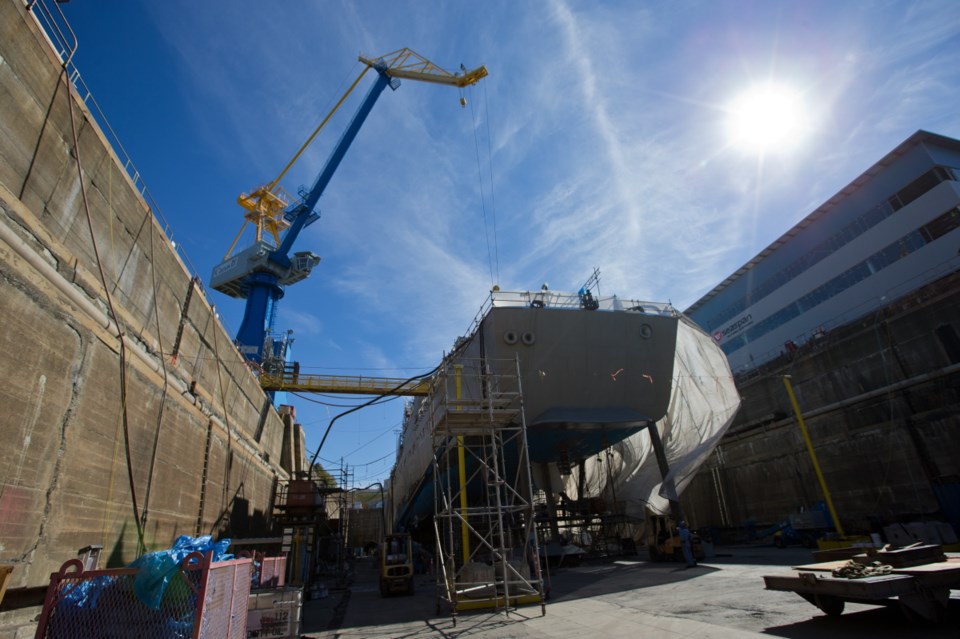Victoria Shipyards has laid off 250 workers now that a five-year federal frigate upgrading contract has come to an end and the Esquimalt Graving Dock has shut down until early September.
The job cuts come as $2.9 million of funding to support shipbuilding trades training was announced in North Vancouver today.
Victoria Shipyards workers have been laid off during the past six weeks, Jonathan Whitworth, CEO of Seaspan, said from Vancouver. Seaspan owns Victoria Shipyards, which works out of the federally owned graving dock. Seaspan also owns Vancouver Shipyard and Vancouver Drydock.
The graving dock closed Wednesday for repair work on its pumps, Whitworth said. “We can’t control when the owner of the graving dock closes down.” The graving dock is expected to reopen in early September, when more ships will be coming in for repair, Whitworth said.
Layoffs were expected after the final frigate work, worth more than $350 million, was completed in May, Whitworth said. Final work wrapped up over a matter of weeks and some workers have been using their accumulated overtime.
Victoria Shipyards still has 250 to 300 trades workers and another 100 office staff remaining in Esquimalt to work on federal submarines, which do not require the graving dock, Whitworth said.
Worker numbers are anticipated to increase by about 250 in the fall when more contracts come in, he said.
However, the make up of the trades will be different. For example, a large number of electricians worked on the highly complex frigate program. The first vessel arriving at Victoria Shipyards this fall requires steel work, Whitworth said.
The first of two New Zealand frigates coming to Victoria Shipyards for upgrading is slated to arrive in spring 2017. The first scientific vessel being built at Vancouver Shipyard under a multi-billion-dollar federal program is expected to arrive at Victoria Shipyards sometime between April and June of 2017, he said. It will remain here for final work and trials for between two and four months.
The Dennis and Phyllis Washington Foundation announced a $900,000 donation today to be equally split among Camosun College to encourage women in trades, the Canadian Welding Association Foundation to support trades in high schools, and the B.C. Institute for Technology to encourage aboriginal students in trades. Seaspan is part of the Washington Companies.
Another $2 million was earlier announced and is going to the University of B.C. for naval and marine engineering programs.
Training money will go to the next generation of shipyard workers, Whitworth said.
Seaspan is building non-combat vessels and Irving Shipbuilding is building combat vessels under a federal program developed to help end the boom and bust cycle in Canada’s shipbuilding industry.
Although these huge contracts have breathed new life into the sector, it remains a cyclical with jobs dependent on yards winning contracts, which may be fought over internationally.
Philip Venoit, Vancouver Island president of the British Columbia and Yukon Territory Building and Construction Trades Council, said that about 75 electricians at the yard have been cut in slightly more than a month.
This represents the natural cycle of the shipbuilding and repair industry, which ebbs and flows depending on the needs of clients, he said.
Electricians from the shipyard will return to the building construction sector, where many of them originally had worked, he said.
However, Venoit is frustrated that B.C. Ferries repair and upgrading work is leaving the province, pointing to the decision this year to award a $140-million contract to a Polish shipyard to convert the Spirit class ferries to dual fuel so that they can run on liquefied natural gas as well as diesel.
“At least facilitate the ability for B.C. shipyards to even submit a bid,” he said.
If B.C. is going to accept bids from offshore, then a local bid should be evaluated by considering economic factors such as the income tax paid by local workers, other government revenues and spin off effects that would occur if the job was completed here, Venoit said.
B.C. shipyards need work from the federal government, the private sector, and B.C. Ferries to succeed, he said.



